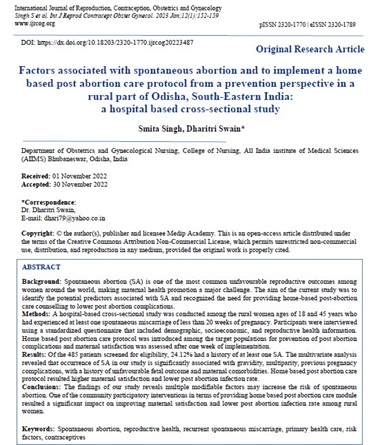
Background: Spontaneous abortion (SA) is one of the most common unfavourable reproductive outcomes among women around the world, making maternal health promotion a major challenge. The aim of the current study was to identify the potential predictors associated with SA and recognized the need for providing home-based post-abortion care counselling to lower post abortion complications. Methods: A hospital-based cross-sectional study was conducted among the rural women ages of 18 and 45 years who had experienced at least one spontaneous miscarriage of less than 20 weeks of pregnancy. Participants were interviewed using a standardized questionnaire that included demographic, socioeconomic, and reproductive health information. Home based post abortion care protocol was introduced among the target populations for prevention of post abortion complications and maternal satisfaction was assessed after one week of implementation. Results: Of the 485 patients screened for eligibility, 24.12% had a history of at least one SA. The multivariate analysis revealed that occurrence of SA in our study is significantly associated with gravidity, multiparity, previous pregnancy complications, with a history of unfavourable fetal outcome and maternal comorbidities. Home based post abortion care protocol resulted higher maternal satisfaction and lower post abortion infection rate. Conclusions: The findings of our study reveals multiple modifiable factors may increase the risk of spontaneous abortion. One of the community participatory interventions in terms of providing home based post abortion care module resulted a significant impact on improving maternal satisfaction and lower post abortion infection rate among rural women.
Singh, S., & Swain, D. (2022). Factors associated with spontaneous abortion and to implement a home based post abortion care protocol from a prevention perspective in a rural part of Odisha, South-Eastern India: a hospital based cross-sectional study. International Journal of Reproduction, Contraception, Obstetrics and Gynecology, 12(1), 152–159.